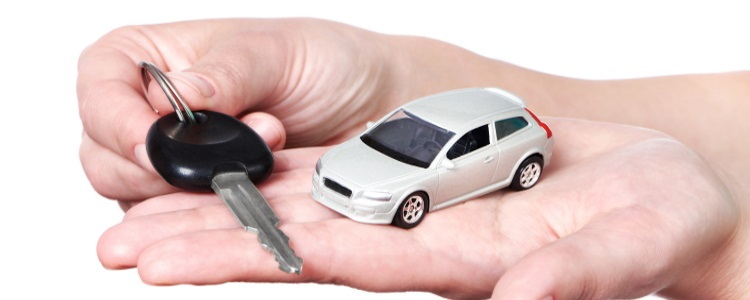Trading in a Car With a Lien
A lien is what gives the lender the right to repossess the vehicle if you stop paying on the loan. So, your vehicle’s title has the lienholder on it, which is your lender. If you still have a loan on your vehicle, you need to remove that lien from the title to sell the car.
Removing a lien means paying off the loan, either naturally through payments during the loan term or when you get enough money to pay everything you owe. If you need to trade in your car while it still has a loan, it’s in your best interest to get an offer large enough to cover your loan balance. If you don't, you need to use your own funds to cover the difference.
This is where your vehicle’s value comes into play. There are a few different values of your car, but the one you need to look at is the trade-in value. You can use online valuation sites to see what your vehicle is worth. Keep in mind, these are just estimates, but if your trade-in value is consistently higher than your loan balance, you’re likely in a good position to trade-in in your car.
This is called being in an equity position since you owe less on your loan than what your car is worth – it’s a great thing! If you get a larger offer that more than covers your loan balance, that equity can be put toward your next vehicle purchase as a down payment or you can pocket the money. If you find that you don’t have equity, it’s more of a sticky situation but it’s still solvable.
Trading in a Car with Equity

In a best-case scenario, the buyer who wants to trade in a vehicle that they're making payments on has equity in the vehicle. This means that the car's current trade-in value is higher than its loan balance. In this situation, the trade-in process is fairly simple.
For example, let's say that a buyer wants to purchase a $25,000 vehicle. They also want to trade in a car that's valued at $8,000. This buyer still owes $5,000 on their current loan, but that's OK. The dealer simply pays off the loan balance and applies the remaining $3,000 toward the purchase price of the new car.
So, if you know that you have equity in the vehicle that you want to trade in, you should have nothing to worry about. If you're unsure about the equity you might have, you should first call your current lender and ask what your loan payoff amount is. Then, you can consult one of the main vehicle valuation guides online, such as NADAguides, in order to get an estimate of your car's current trade-in value.
On the other hand, if the outstanding balance on your loan is more than what your vehicle is worth, you have negative equity. In this situation, trading a car in on the purchase of another vehicle gets more complicated.
Trading in a Car with Negative Equity
Having negative equity in a vehicle (or being "upside down") makes it more difficult to trade that car in. This is because the difference between your vehicle's value and the loan balance isn't going to just disappear. Negative equity is when you owe more on your car loan than what the vehicle can be sold or traded in for. This can happen to borrowers who recently financed a new car that lost its value quickly or to borrowers with loans that have a high interest rate that makes paying down the loan quickly more difficult.
Here are two examples of how trading in a car with negative equity is possible.
- Buyer A wants to purchase a $30,000 vehicle. They have a car that they want to trade in that the dealer has appraised and valued at $10,000. However, they still owe $12,000 on the loan. Luckily, Buyer A is willing and able to pay the $2,000 difference out of pocket. The lien is removed and Buyer A only has to worry about making payments on the new car.
There is a way to trade in a vehicle with negative equity without having to pay it off upfront. It’s called rolling over negative equity. Let's look at Buyer B, who is in a rollover situation.
- Buyer B wants to purchase a $40,000 vehicle. This buyer has a vehicle to trade in that's valued at $6,000. Unfortunately, Buyer B owes $11,000 on the loan. They knew that they were upside down before going to the dealership. They chose this particular dealer because of their advertised claim. The dealership said that they would "pay off your loan, no matter how much you owe." And, yes, this dealer does pay off Buyer B's loan balance in order to remove the lien from the vehicle. But the $5,000 difference between the car's trade-in value and the loan pay-off amount is rolled over into Buyer B's new loan. So, Buyer B's $40,000 vehicle now has a $45,000 loan. Buyer B will have to pay $5,000, plus interest charges, on a car that they no longer own. And unless Buyer B is able to provide a very good down payment, they'll immediately be even further upside down in the new car.
Trading In a Car With Bad Credit
It may not be too hard to find a dealership in your area to accept your trade-in, but finding a dealer with bad credit lending options isn’t all that common. If you’re in need of a bad credit auto loan, a special finance dealership could help increase your approval odds.
Trade-ins also increase your chances of car loan eligibility, since most bad credit lenders, or subprime lenders, require a down payment. If your trade-in has equity, it could help you meet the down payment requirement.
Getting a trade-in offer can be as easy as calling a few dealerships in your area – but not all dealers are equipped to help with credit challenges.
Why Rolling Over a Loan Balance Can Be Risky
Even if a dealer is able to roll a balance from an old loan into a new one, this may not be the best option. Doing this means that you have to take out a bigger loan and pay more in interest charges.
So, if you're thinking about trading in a car that you're upside down in, you may want to wait. It'll be better for your wallet in the long run if you have equity in your current vehicle.
Of course, you can always try to sell the car yourself. You may be able to get more than you would when trading in your vehicle at a dealership. This may allow you to eliminate or further reduce any negative equity.
Buying a Vehicle with a Bad Credit Car Loan
If you're worried that your bad credit will make it impossible to get a car loan, Auto Credit Express can help. We can match you with a dealership in your area that specializes in helping buyers with imperfect credit.
Our process is fast and the free service that we provide comes with no obligations. So, what are you waiting for? Go ahead and fill out our secure auto loan request form to get started today!
















